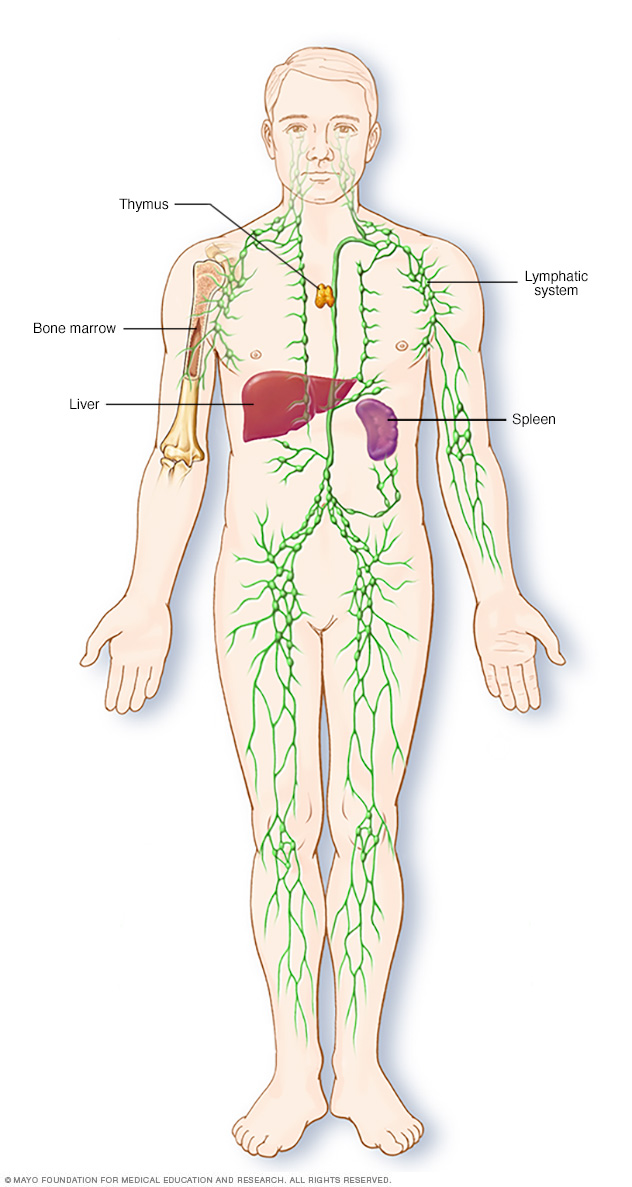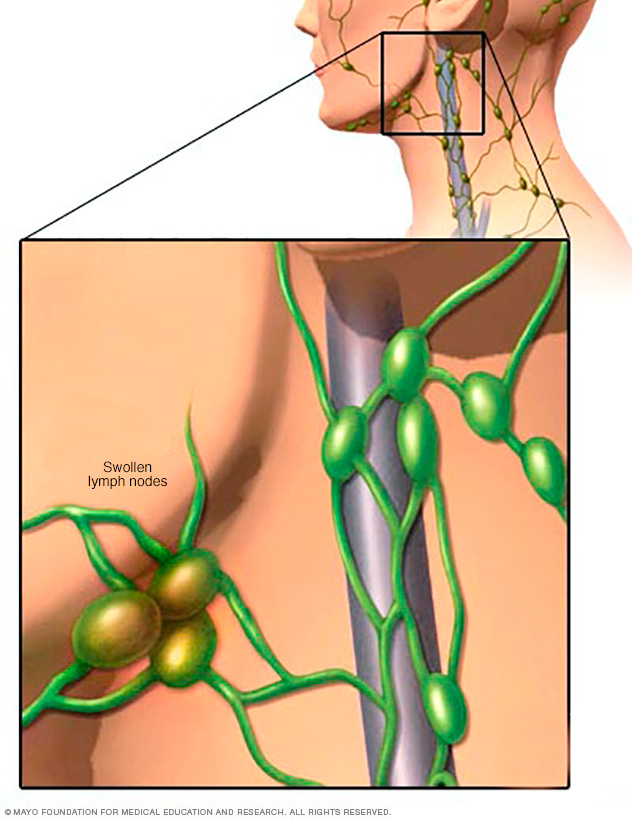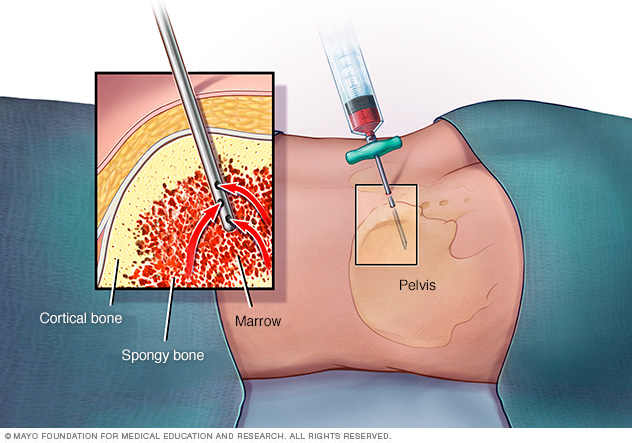Overview
Hodgkin lymphoma is a type of cancer that affects the lymphatic system. The lymphatic system is part of the body's germ-fighting and disease-fighting immune system. Hodgkin lymphoma begins when healthy cells in the lymphatic system change and grow out of control.
The lymphatic system includes lymph nodes. They are found throughout the body. Most lymph nodes are in the abdomen, groin, pelvis, chest, underarms and neck.
The lymphatic system also includes the spleen, thymus, tonsils and bone marrow. Hodgkin lymphoma can affect all these areas and other organs in the body.
Hodgkin lymphoma, which used to be called Hodgkin disease, is one of two broad types of lymphoma. The other is non-Hodgkin lymphoma.
Advances in diagnosis and treatment of Hodgkin lymphoma have helped give people with this disease the chance for a full recovery.

Symptoms
Signs and symptoms of Hodgkin lymphoma may include:
- Painless swelling of lymph nodes in the neck, armpits or groin.
- Fever.
- Feeling very tired.
- Night sweats.
- Weight loss that happens without trying.
- Itchy skin.
When to see a doctor
Make an appointment with a doctor or other healthcare professional if you have ongoing symptoms that worry you. Hodgkin lymphoma symptoms are like those of many more-common conditions, such as infections. The healthcare professional may check for those causes first.

Causes
Healthcare professionals aren't sure what causes Hodgkin lymphoma. It begins with changes in the DNA of a disease-fighting blood cell called a lymphocyte. A cell's DNA contains the instructions that tell the cell what to do.
The DNA changes tell the cells to multiply quickly and live when other cells would naturally die. The Hodgkin lymphoma cells attract many healthy immune system cells to protect them and help them grow. The extra cells crowd into the lymph nodes and cause swelling and other symptoms.
There are multiple types of Hodgkin lymphoma. The type of lymphoma you have is based on the characteristics of the cells involved in your disease and their behavior. The type of lymphoma you have helps determine your treatment options.
Classical Hodgkin lymphoma
Classical Hodgkin lymphoma is the more common type of this disease. People diagnosed with this type have large lymphoma cells called Reed-Sternberg cells in their lymph nodes.
Subtypes of classical Hodgkin lymphoma include:
- Nodular sclerosis Hodgkin lymphoma.
- Mixed cellularity Hodgkin lymphoma.
- Lymphocyte-depleted Hodgkin lymphoma.
- Lymphocyte-rich Hodgkin lymphoma.
Nodular lymphocyte-predominant Hodgkin lymphoma
This type of Hodgkin lymphoma is much rarer. It involves lymphoma cells sometimes called popcorn cells because of how they look. Usually, it is diagnosed early and may need less intensive treatments than the classical type of Hodgkin lymphoma.
Risk factors
Factors that can increase the risk of Hodgkin lymphoma include:
- Your age. Hodgkin lymphoma is most often diagnosed in people in their 20s and 30s and those over age 65.
- A family history of Hodgkin lymphoma. Having a blood relative with Hodgkin lymphoma increases the risk of Hodgkin lymphoma.
- Being male. People who are assigned male at birth are slightly more likely to develop Hodgkin lymphoma than are those who are assigned female at birth.
- Past Epstein-Barr infection. People who have had illnesses caused by the Epstein-Barr virus are at higher risk of Hodgkin lymphoma than are those who haven't. One example is infectious mononucleosis.
- HIV infection. People who are infected with HIV have an increased risk of Hodgkin lymphoma.
There's no way to prevent Hodgkin lymphoma.
Diagnosis
Hodgkin lymphoma diagnosis often begins with an exam that checks for swollen lymph nodes in the neck, underarm and groin. Other tests include imaging tests and removing some cells for testing. The type of tests used for diagnosis may depend on the lymphoma's location and your symptoms.
Physical exam
A healthcare professional may start by asking about your symptoms. The health professional also may ask about your health history.
Next, the healthcare professional may feel and press on parts of your body to check for swelling or pain. To find swollen lymph nodes, the healthcare professional may feel your neck, underarms and groin. Be sure to say if you have felt any lumps or pain.
Blood tests
A sample of your blood is examined in a lab to understand your health and look for signs of cancer.
Biopsy
A biopsy is a procedure to remove a sample of tissue for testing in a lab. For Hodgkin lymphoma, the biopsy typically involves removing one or more lymph nodes. The lymph nodes go to a lab for testing to look for cancer cells. Other special tests give more details about the cancer cells. Your healthcare team uses this information to make a treatment plan. Sometimes a biopsy is taken from other parts of the body, such as the liver, to look for signs of Hodgkin lymphoma.
Imaging tests
Your healthcare team may recommend imaging tests to look for signs of lymphoma in other areas of your body. Tests may include a chest X-ray, CT, MRI and positron emission tomography scans, also called PET scans.
Bone marrow aspiration and biopsy
Bone marrow aspiration and biopsy are procedures that involve collecting cells from the bone marrow. The cells are sent for testing. Tests can look for Hodgkin lymphoma cells.
Hodgkin lymphoma stages
Your test results are used to assign a stage to your Hodgkin lymphoma. The stage helps determine the seriousness of your condition and the treatments most likely to help you.
Hodgkin lymphoma staging uses the numbers 1 to 4 to indicate the stage. A lower number means the lymphoma cells only involve one or a few areas of lymph nodes. An early-stage cancer is more likely to be cured. As the lymphoma grows to involve more areas of the body, the stage number goes up. A higher number means the cancer is more advanced.
Hodgkin lymphoma stages also may include the letters A and B. The letter A means that you don't have worrying symptoms of lymphoma. The letter B means that you have some symptoms, such as fever or weight loss.

Treatment
Many types of treatments exist for Hodgkin lymphoma. Treatment often starts with chemotherapy. Your healthcare team might check to see how the lymphoma is responding and decide whether you need more treatment. Your options might include radiation therapy, chemotherapy, immunotherapy, targeted therapy and bone marrow transplant, also called stem cell transplant. Sometimes, a combination of treatments is used.
The treatment that's best for you depends on the type of Hodgkin lymphoma that you have. Your healthcare team also might consider the stage of your lymphoma, whether you have any symptoms and your overall health.
Chemotherapy
Chemotherapy treats cancer with strong medicines. Many chemotherapy medicines exist. Most chemotherapy medicines are given through a vein. Some come in pill form.
Classical Hodgkin lymphoma treatment usually involves a combination of chemotherapy and radiation therapy. Sometimes chemotherapy may be the only treatment needed. More-advanced disease may be treated with a combination of chemotherapy and medicines that attack specific chemicals in cancer cells, known as targeted therapy.
For nodular lymphocyte-predominant Hodgkin lymphoma, chemotherapy may be combined with targeted therapy and radiation therapy.
Side effects of chemotherapy depend on the medicines you're given. Common side effects are nausea and hair loss. Serious long-term complications can occur, such as heart disease, lung damage, fertility problems and other cancers.
Radiation therapy
Radiation therapy treats cancer with powerful energy beams. The energy can come from X-rays, protons or other sources. During radiation therapy, you lie on a table while a machine moves around you. The machine directs radiation to precise points on your body.
For Hodgkin lymphoma, radiation can be aimed at affected lymph nodes and the nearby areas where the disease might spread. It's usually used with chemotherapy. Radiation therapy may be the only treatment needed for early-stage nodular lymphocyte-predominant Hodgkin lymphoma.
Radiation therapy side effects include fatigue and a sunburn-like reaction on the skin at the site where the radiation is aimed. Other side effects depend on where the radiation is aimed. Radiation to the neck can cause dry mouth and hurt the thyroid. Radiation to the chest can hurt the heart and lungs.
Bone marrow transplant
A bone marrow transplant, also called a bone marrow stem cell transplant, involves putting healthy bone marrow stem cells into the body. These cells replace cells hurt by chemotherapy and other treatments. A bone marrow transplant may be an option if Hodgkin lymphoma returns or doesn't respond to other treatments.
During a bone marrow transplant, your own blood stem cells are removed, frozen and stored. Next, you receive high-dose chemotherapy and radiation therapy to destroy cancer cells in your body. Finally, the stored stem cells are thawed and put back in your body to help build healthy bone marrow.
There is an increased risk of infection after a transplant.
Targeted therapy
Targeted therapy for cancer is a treatment that uses medicines that attack specific chemicals in cancer cells. By blocking these chemicals, targeted therapy can cause cancer cells to die. Targeted therapy is often combined with chemotherapy for treating nodular lymphocyte-predominant Hodgkin lymphoma.
For classical Hodgkin lymphoma, targeted therapy might be an option in certain situations.
Immunotherapy
Immunotherapy for cancer is a treatment with medicine that helps the body's immune system kill cancer cells. The immune system fights off diseases by attacking germs and other cells that shouldn't be in the body. Cancer cells survive by hiding from the immune system. Immunotherapy helps the immune system cells find and kill the cancer cells.
For Hodgkin lymphoma, immunotherapy might be considered in certain situations, such as if the disease doesn't respond to other treatments.
Alternative medicine
No alternative medicines have been found to treat Hodgkin lymphoma. But integrative medicine may help you cope with the stress of a cancer diagnosis and the side effects of cancer treatment.
Talk with your healthcare professional about your options, such as:
- Art therapy.
- Exercise.
- Meditation.
- Music therapy.
- Relaxation exercises.
- Spirituality.
Coping and support
A Hodgkin lymphoma diagnosis can be challenging. The following strategies and resources may help you cope with your diagnosis:
Learn about Hodgkin lymphoma
Learn enough about your cancer to feel comfortable making decisions about your treatment and care. Talk with your healthcare team. Look for information at your local library and on the internet. You can start your information search with the Lymphoma Research Foundation and the Leukemia & Lymphoma Society.
Maintain a strong support system
Having a support system can help you cope. Get support from friends, family, a formal support group or others coping with cancer.
Set reasonable goals
Having goals can help you feel in control and give you a sense of purpose. Avoid setting goals you can't possibly reach. For example, if you can't work full time, you may be able to work part time. Many people find that continuing to work can be helpful.
Take time for yourself
Eating well, relaxing and getting enough rest can help combat the stress and fatigue of cancer. Plan for downtime when you may need to rest or limit what you do.
Stay active
Receiving a diagnosis of cancer doesn't mean you have to stop doing the things you enjoy. If you feel well enough to do something, do it. It's important to stay active and involved as much as you can.
Preparing for an appointment
Make an appointment with a doctor or other healthcare professional if you have any symptoms that worry you. You may be referred to a doctor who specializes in diseases that affect the blood cells. This type of doctor is called a hematologist.
Appointments can be brief, and there's often a lot of information to discuss. So it's a good idea to be prepared. Here's some information to help you get ready.
What you can do
- Be aware of any pre-appointment restrictions. At the time you make the appointment, be sure to ask if there's anything you need to do in advance, such as restrict your diet before testing.
- Write down any symptoms you're experiencing, including any that may seem unrelated to the reason for which you scheduled the appointment.
- Write down key personal information, including any major stresses or recent life changes.
- Make a list of all medications, vitamins or supplements you're taking.
- Consider taking a family member or friend along. Sometimes it can be difficult to absorb all the information provided during an appointment. Someone who accompanies you may remember something that you missed or forgot.
- Write down questions to ask.
Your time with your healthcare professional is limited, so preparing a list of questions can help you make the most of your time together. List your questions from most important to least important in case time runs out. For Hodgkin lymphoma, some basic questions to ask include:
- Do I have Hodgkin lymphoma?
- What type of Hodgkin lymphoma do I have?
- What stage is my condition?
- Will I need more tests?
- Will I need treatment?
- What are my treatment options?
- What are the potential side effects of each treatment?
- How will treatment affect my daily life? Can I continue working?
- How long will treatment last?
- Is there one treatment you believe is best for me?
- If you had a friend or loved one in my situation, what advice would you give that person?
- Should I see a specialist? What will that cost, and will my insurance cover it?
- Do you have brochures or other printed material that I can take with me? What websites do you recommend?
In addition to the questions that you've prepared, don't hesitate to ask additional questions.
What to expect from your doctor
Your healthcare professional is likely to ask you questions. Being ready to answer them may save time to go over points you want to spend more time on. The questions may include:
- When did you first begin experiencing symptoms?
- Have your symptoms been continuous or occasional?
- How severe are your symptoms?
- What, if anything, seems to improve your symptoms?
- What, if anything, appears to worsen your symptoms?
- Has anyone in your family had cancer, including Hodgkin lymphoma?
- Have you or anyone in your family had conditions affecting the immune system?
- Have you had infections in the past?
- Have you or your family been exposed to toxins?
© 1998-2025 Mayo Foundation for Medical Education and Research (MFMER). All rights reserved. Terms of Use


